 Pirates and Privateers Pirates and Privateers
The History of Maritime
Piracy
Cindy Vallar, Editor
& Reviewer
P.O. Box 425,
Keller, TX 76244-0425
    
Books for Pirate Apprentices ~
Biography
 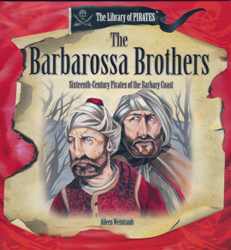 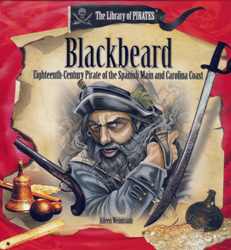
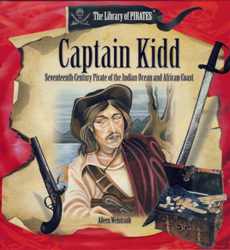 
The Library of Pirates
Anne Bonny and Mary Read: Fearsome
Females of the Eighteenth Century, ISBN 0-8239-5795-0
The
Barbarossa Brothers: Sixteenth-century Pirates of
the Barbary Coast, ISBN 0-8239-5799-3
Blackbeard: Eighteenth-century Pirate of the Spanish
Main and Carolina Coast, ISBN 0-8239-5794-2
Captain Kidd: Seventeenth-century Pirate of the
Indian Ocean and African Coast, ISBN 0-8239-5797-7
Jean Lafitte: Pirate Hero of the War of 1812, ISBN
0-8239-5796-9
by Aileen Weintraub
Rosen, 2002, US $18.75 each
One of
Rosen Publishing Group's newest series of books
introduces pirate apprentices to an interesting
assortment of pirates who terrorize the High Seas
from the 1500s through the 1800s. The books are
twenty-four pages long, and include a glossary,
index, and recommended websites. Each double-page
spread consists of an illustration and text
detailing some aspect of the pirates' lives.
Children will delight in the skull-and-cutlass
borders that decorate the pages and the text that
appears on curled parchment with tattered and burned
edges.
The Barbarossa Brothers attack ships in the
Mediterranean Sea. Few books, especially those
written for children, discuss the Barbary corsairs,
so I'm delighted to see Arouj and Kheir-ed-din
included in this series. Contrary to the title, the
book is primarily about Kheir-ed-din rather than
both brothers, whose red beards give them the name
by which history remembers them. He becomes a legend
in his own time, and Weintraub does a commendable
job relating the details of his career without
allowing the religion and politics of the period to
overwhelm the story. The perfect book for young
pirate fans who want to know about lesser-known
pirates who achieve great notoriety.
Most children have heard of Blackbeard, perhaps the
most notorious of all pirates. Weintraub enriches
the telling of his story as she separates fact from
legend. The illustrations are wonderful portrayals
of the fierce pirate, who employs techniques of
psychological warfare to instill terror in his
victims. She also discusses his flagship, Queen
Anne's Revenge, which archaeologists believe
they have found along the North Carolina coast. This
is the best book in the series.
In contrast, Anne Bonny and Mary Read is the
least well-done of the pirate books. Little of their
adventures prior to capture can be authenticated in
primary documents, but the author presents these
legends as fact. Also, the editing of the book is
sloppy. The inclusion of some pictures will leave
readers wondering why, as in the case of a map of
Europe 100 years after Mary's death. The section
dealing with how these two infamous pirates meet
begins with "Anne and Mary had to make sure that the
other pirates didn't find out they were women."
Further down the page it reveals that Anne doesn't
try hard to maintain her disguise, while the caption
for the accompanying picture says the opposite.
Is Captain Kidd a pirate or isn't he? What
does he do with all his treasure? These questions
have puzzled historians for many years. The author
concisely explains the circumstances surrounding
this Scotsman without getting bogged down in
details. Although little is known of his early life,
she does include personal information about him
prior to the privateering venture that results in
his piracy trial. The illustrations in this book are
some of the best in the series, but some younger
pirate apprentices may have problems with one of
Kidd's body on display as a warning to other
pirates. An excellent introduction to Captain
William Kidd and his adventures.
One problem that any author encounters when
researching Jean Lafitte is determining
whether something is legend or fact. He is a
consummate master at steeping himself in mystery,
never telling the same story about his background or
deeds twice. Unfortunately, the author continues to
perpetuate some of the myths about him. There are
several factual errors in the book as well. William
C. C. Claiborne, Lafitte's nemesis, is governor of
Louisiana not New Orleans. The Baratarians, the
smugglers and privateers who become Lafitte's men,
approach him rather than the other way around. While
his and the Baratarians' participation in the Battle
of New Orleans is discussed, no clear explanation is
given as to why their services earn them a
presidential pardon and the status of heroes. Andrew
Jackson is woefully short of men, ammunition, and
arms, all of which Lafitte supplies. Members of the
Laffite Society have done significant research into
his life in recent years, but the author doesn't
seem to have partaken of their findings. I also
wonder why she chooses the more conventional
spelling of Lafitte rather than spelling his name as
he does, Laffite.
(One additional title in
this series is not reviewed: Henry Morgan (ISBN
0-8239-5798-5). The publisher recommends this
series for children who are 8 years old.)
Review -
Copyright ©2002 Cindy Vallar

 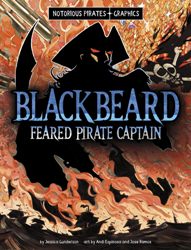  
Notorious Pirates Graphics set
ISBN 978-1-66906-984-3, US $113.96
All titles available in other formats
Capstone Press, 2025
Black Bart:
Daring Pirate of the Atlantic by Jessica
Gunderson and illustrated by Matt Kinder and
Jose Ramos
ISBN 978-1-66906-973-7, US $28.49
Blackbeard:
Feared Pirate Captain by Jessica
Gunderson and illustrated by Andi
Espinosa and Jose Ramos
ISBN 978-1-66906-965-2, US $26.64
Ching
Shih: Famous Pirate Commander by
Stephanie Peters and illustrated by
Lia Liao
ISBN 978-1-66906-957-7, US $28.49
Grace
O’Malley: Pirate Queen of Ireland by Stephanie
Peters and illustrated by Paulina Wyrt and Jose
Ramos
ISBN 978-1-66906-981-2, US $28.49
Daughter
of a chieftain and pirate, Grace O’Malley
chops off her hair and hides aboard her
father’s ship until they are so far out at sea
that he can’t tell her to go home. The day
eventually comes when her mother puts her foot
down and Grace must follow the traditional
role of a woman in 16th-century Ireland.
Later, she returns to the sea to become a
pirate leader and dares to meet face-to-face
with the English queen to save her son in Grace
O’Malley.
When England is at war with France, a youth
named Edward Teach joins a crew of privateers,
but when peace comes, he signs aboard a pirate
ship captained by the infamous Benjamin
Hornigold, who teaches Edward how to be a
pirate. Before long, he becomes famous in his
own right and earns a moniker that instills
fear in anyone who crosses his path: Blackbeard.
Rather than farm the land, John Roberts joins
the British Navy and seeks adventure. Later,
he joins the crew of a merchant ship, which
encounters pirates. He is forced to join their
ranks, but soon discovers that the perks of
plundering other ships will make his life
richer. When his captain is ambushed and
slain, the crew elects Roberts to be their
commander. He chooses a new name and wreaks
havoc everywhere he sails in Black Bart.
To survive, young Ching Shih serves men who
visit her place of work. She overhears men
talking, and she offers the information to a
pirate for a price. They marry and she becomes
his partner. Their success garners them many
riches and much power. When her husband dies,
she finds a way to continue to lead the Red
Fleet and to instill fear in the heart of the
Chinese emperor in Ching Shih.
Notorious Pirates is a series of four graphic
novels geared toward pirate apprentices. Each
pirate’s life unfolds from earliest days to
the end of his or her piratical career. Fact
is entwined with legend, sometimes to fill in
gaps, sometimes to further entice readers.
Each book is divided into five chapters and
includes additional facts about the pirate, a
glossary, and several internet sites where
additional information can be found. The text
combines dialogue and narrative to provide a
cohesive tale from start to finish. The
artwork grabs the reader’s attention and the
artists incorporate a variety of techniques to
instill emotion into the scenes. Those found
in Blackbeard are particularly good at
portraying victims’ terror and Blackbeard’s
fearsomeness. I particularly like how the
artists of this book depict the final battle
between Blackbeard and Lieutenant Maynard;
it’s visually stunning without being bloody
and gory. Equally compelling is how the
artists depict a duel between a pirate and a
sailor in Black Bart.
There are some issues with the books that may
or may not bother readers. Unfortunately, the
inclusion of websites is problematic. It’s
great to provide additional information, but
not all of the URLs are current. For example,
the last one listed in Grace O’Malley
– Twinkl: Who Was Grace O’Malley? – is no
longer viable. I did a search to see whether
the URL had changed, but the information that
answers the question is no longer there.
Instead “Grace O’Malley” turned up a variety
of visuals and activities for use in the
classroom.
While most of the artwork vividly depicts
scenes and action, the graphics do have some
shortcomings. The clothing in Grace
O’Malley is that of a later period than
the one in which she lives. Vessels of the
1500s do not have staircases – nor do those of
Blackbeard’s days – and the types of cannons
used on the ships differ from those of later
centuries. The vessels Ching Shih and her
pirates sail are junks, yet those pictured
show them as being predominately Western-style
ships. This detracts from the setting and
misleads the reader.
There are also a few historical inaccuracies.
One graphic perpetuates the myth of walking
the plank. The golden age of piracy does not
begin in 1701; it occurs after the War of the
Spanish Succession ends in the next decade.
This is supposedly why Blackbeard turns to
piracy. While the depiction of how he meets
Stede Bonnet is humorous, in actuality, Bonnet
is gravely injured and on the mend at the time
Blackbeard commandeers Bonnet’s ship.
Since this series is geared toward younger
pirates in training (Reading Level: grades
2-3, Interest Level: 4-6), these books will be
popular with this age group and the reinforced
library bindings of the hardback editions
guarantee they will stand up to frequent
usage. They serve as good introductions to the
pirates, and the inclusion of two females and
two males ensures that the books will interest
girls and boys equally. The stories do gloss
over some of the seamier aspects of these
pirates’ lives, so parents and teachers need
not worry about this. I recommend that further
investigations into these pirates be paired
with these books so readers receive a fuller
and more accurate picture of who Grace
O’Malley, Blackbeard, Black Bart, and Ching
Shih really were.
Meet
illustrator Paulina Wyrt
Meet
illustrator Jose Ramos
Meet
illustrator Lia Liao
Review Copyright
©2025 Cindy Vallar

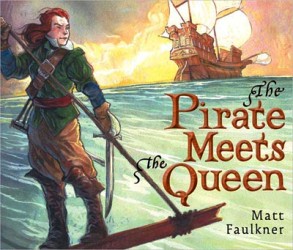
The Pirate Meets the Queen
by Matt Faulkner
Philomel Books, 2005, ISBN 0-399-24038-1, US
$15.99 / CAN $23.50
Granny
O’Malley loves the sea. When her mother
forbids her to sail aboard her father’s Stallion,
she chops off her hair and dresses in boys’
clothes and stows aboard the galley. Ma
refuses to be deterred; Granny soon finds
herself wed to an Irish chief’s son. Even this
fails to keep her from her first love, and
over the years, she becomes a fine sailor and
fiercesome pirate. Her constant attacks on
English ships so angers Red Liz that the
English Queen declares Granny an outlaw. Her
kinfolk suffer for Granny’s piracy, but she
protects them as best she can.
When her son, Toby, turns seventeen, he
captains his own vessel, but his recklessness
leads to his capture. Knowing the English will
hang her son, Granny visits Red Liz in faraway
London to ask for a pardon for Toby.
This “illuminated tale” introduces two
remarkable women to children: Grace O’Malley
and Elizabeth I. Told in the first person,
Granny relates the important events in her
life that eventually lead to her famous
meeting with the English Queen, her enemy. The
author confesses in his note to readers “that
some of what I’ve written is true and some of
it is a little fanciful. It’s the way of
storytelling.” This is what makes The
Pirate Meets the Queen a captivating
story. He remains true to the known facts with
one exception. He confuses Granny’s first
marriage with that of her second. This is a
minor foible, and one that doesn’t detract
from the rich details and fascinating life
that Granny leads. The illustrations capture
the essence of Ireland, and enrich this tale
of how far a mother will go to protect her
child.
Review Copyright ©2005 Cindy
Vallar

 Swashbuckling
Scoundrels: Pirates in Fact and Fiction
Swashbuckling
Scoundrels: Pirates in Fact and Fiction
by Arie Kaplan
Twenty-first Century Books, 2015, ISBN
978-1-4677-5252-7, $33.32
Available in other formats
Written
for ages ten to eighteen, this seventy-two-page
book explores real-life pirates and compares
them to their fictional counterparts in
literature and pop culture. Kaplan opens with
the 1696 account of Henry Avery’s audacious
trade of the treasure-laden Ganj-i-Sawa’i
with the governor of the Bahamas, but Swashbuckling
Pirates explores the history of pirates
from ancient times to the present.
The book is divided into an introduction (“Of
Fools and Freebooters”) and four chapters.
“Scourge of the Seas” presents the early history
of pirates around the world from the earliest
known pirates, the Sea Peoples of the
Mediterranean (circa 1200 BCE), to the wakō of
eastern Asia (1200s to mid-1500s). “The Golden
Age of Piracy” begins with an explanation of
legal piracy and European exploration of the New
World in the 16th century. Kaplan briefly
mentions Sea Dog Sir Francis Drake and the
buccaneers, before focusing on Captain William
Kidd, pirate life after the War of the Spanish
Succession (1701-1714), slaves, and black
pirates. Particular emphasis is given to
Blackbeard, Anne Bonny, and Mary Read. “From
Sabers to Rocket Launchers” looks at piracy
after the golden age. It covers the Barbary
pirates, Cheng I Sao, a Great Lakes pirate,
Somali piracy, and the current resurgence of
piracy in Asian waters. The final chapter (“Pop
Culture Pirates”) explores pirate imagery in our
daily lives and the evolution of piratical
portrayals in books, movies, and television from
1713 to today. It concludes with a brief
discussion of how society romanticizes these
criminals.
In addition to the narrative, the book is filled
with captioned pictures (artistic portrayals of
pirates, maps, and artifacts in
black-&-white and color) and the piratical theme
is carried through from the first page to last.
Parchment-like boxes spread throughout the book
provide historical tidbits, such as William
Fly’s execution, pirate queen Grace O’Malley,
digital piracy, and the comic strip Terry
and the Pirates. Period quotes are also
highlighted in red lettering. The book includes
source notes, a glossary, a selected
bibliography, a list of books, websites, and
films where readers can go for further
information, and an index.
This book is easy to read and the narrative
flows from one section to the next. It is a fair
portrayal of factual and fictional piracy, and
Kaplan makes a clear distinction between the
“noble, heroic, lovable, even comic” pirate of
fiction and the “dangerous and sometimes
bloodthirsty” pirates throughout history. The
material is current and includes mention of
recent news items and films, including Captain
Phillips, as well as the forthcoming release in
2017 of the next installment of The Pirates of
the Caribbean series. What is surprising is the
short-shrift given to the buccaneers, and no
mention is made of Sir Henry Morgan, who is
often called the greatest of these. Some of the
text used in the world map (pages 12-13) isn’t
legible in the e-book version. Also, some
picture placement is questionable. For example,
instead of placing the painting of Stephen
Decatur fighting the Barbary pirates in the
section on the Barbary Wars, it’s placed in the
middle of the text on Cheng I Sao. The
screenshot of Tom Hanks in Captain Phillips
appears in the middle of the section dealing
with television pirates, rather than with the
section discussing the movie itself. The
inclusion of a summary may have helped to make
the ending seem less abrupt.
The price of this book may put it out of the
reach of many pirate apprentices. Swashbuckling
Scoundrel makes a highly recommended and
worthy resource for any school or public library
where the library binding will make the
hardcover stand up to years of use.
Review Copyright ©2015 Cindy Vallar
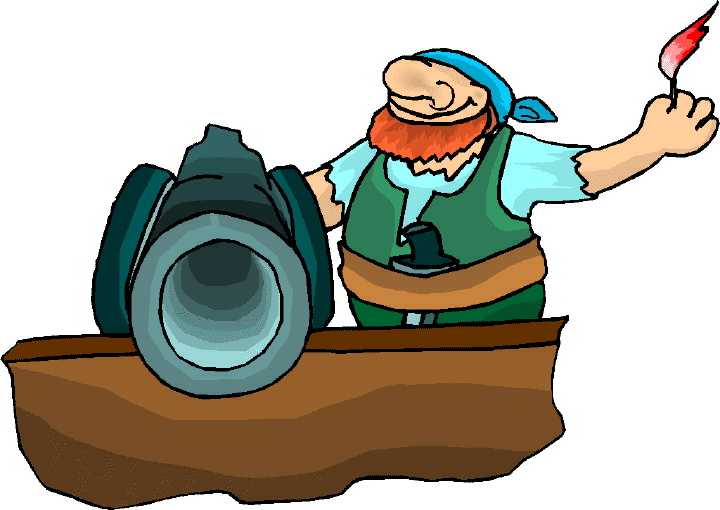
Click to contact me
Background image compliments
of Anke's Graphics |











